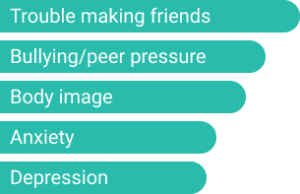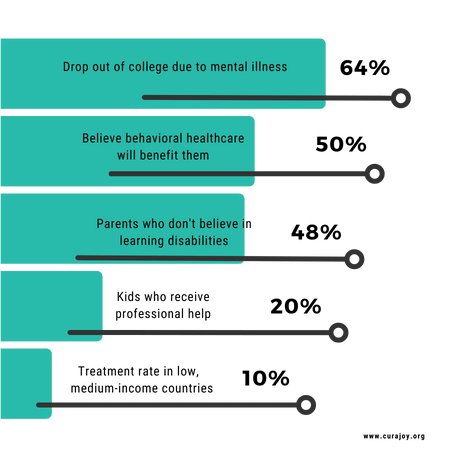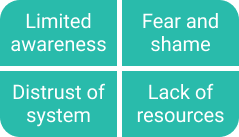When curaJOY first started and began designing our program to improve all family members’ emotional wellness, we expected to mostly hear from parents concerned about their kids’ emotional wellness and social-emotional development. But it was youths—tweens and teens around the world who sought us out, asking for help to become happier and make more friends.


kids surveyed wished their parents cared more about their emotional well-being
What’s worse, 33 percent of educators say that sometimes what people call a learning disability is actually laziness, downplaying the very real stress and burnout people with learning disabilities experience. Because of this, teens are discouraged from seeking out help, believing that they’ll be seen as lazy if they try, or that they are just overreacting to the problems they face.
Over half of the people curaJOY surveyed believe they would benefit from counseling, coaching or other types of behavioral health support. The world is facing an unprecedented shortage of behavioral health professionals (therapists, psychologists). This shortage contributes to the low number of people receiving behavioral healthcare, but another issue is not seeking help. Our youth suffer in silence. Why?
In fall 2022, curaJOY interviewed more than 1,700 families in the United States and East Asia. Thousands of kids shared their struggles with bullying, peer pressure, friendships, and more. Over 50% of kids surveyed believe they would benefit from counseling or other types of support but cited parents’ attitudes as the main barriers to getting help.
Even perfectly typical kids without mental conditions are not immune to anxiety, burnout, or pressure. Many teens feel insecure about themselves for various reasons, from body image to academic success and social media life. Rigorous school life and exaggerated social media posts combined with pressures at home can make even the most cheerful teen feel as though they have nowhere to turn to—as though they are not good enough and never will be. So many teens feel this way to the point where suicide is the fourth leading cause of death in teenagers aged 15-19.


Although technology has dramatically pioneered ways to fight diseases and make life more comfortable, mental health has been mostly left in the dark. To most people, what’s going externally (i.e., physical health and education) are the only things needed to live a happy, successful life. But they don’t realize that youth mental health programs plays a significant role in health and learning. The brain controls the body. If the brain is stressed out and needs help, the body will become stressed. Health declines, and students struggle to learn. Over 50% of kids with emotional, behavioral, and mental health disorders drop out of school. It’s not because they’re immature or simple-minded, but because they didn’t get the mental health care they need and are dealing with stress in unhealthy ways.


More than 52% of LGBTQ suffer from poor mental health of teenagers. This affects their physical wellbeing and educational outcomes.

According to the latest CDC research, more than 1 in 3 teenagers have seriously considered suicide. Adult stress during COVID seeped down to children who do not deserve yelling, put-downs, neglect, and beatings.

Teenage girls are emotionally distressed at a historic high, twice as much as teen boys. 1 in 5 experienced sexual violence just in the last year.
curaJOY creates a one-stop behavioral support program, MyCuraJOY, to serve as a safety net for youth who could otherwise only depend on their caretakers to recognize and accept their distress.
I hired a newbie handyman to replace five faucet fixtures. He and I both assumed he knew what he was doing. Nothing leaked before. That night, every sink he touched started dripping. Three callbacks and extra parts later, the total bill far exceeded what a licensed plumber’s—plus the time and trust you can’t get back.…
Caitlyn Wang’s wonderful article, besides managing to alleviate my anxiety about not taking enough AP courses, also brought up another thought in mind. In her article, there was this quote “Nothing is more fragile than a child who only knows how to chase accolades. Let’s help them learn who they are when the trophies are…
Cyberbullying, defined as willful and repeated harm inflicted through digital means, continues to rise in prevalence and severity, particularly among youth populations, who are exposed to social media at starting at young ages. The mental health consequences of cyberbullying—including anxiety, depression, and suicidal ideation—are well-documented (NIH, 2023). As a result, researchers have increasingly turned to…
In the rapidly evolving world of AI, data is king—but what happens when the data we rely on is synthetic? While data augmentation offers a promising solution to the challenges of collecting real-world examples, it comes with hidden dangers. From the risk of model collapse to the inability to capture the nuances of human language,…
Creating Categories to Combat Cyberbullying A journey through 40+ research papers, heated debates, and yellow sticky notes The Search That Started It All Picture this: A group of Impact Fellows, armed with laptops and determination, diving into the murky waters of cyberbullying research. Our mission? To create a framework that could help AI systems recognize…
Self diagnosis, a hot topic The second reason why autism keeps on getting misused in a lot of memes could be people self diagnosing themselves with autism. Far warning, I will be heading into a rather controversial topic here. But as a person with autism and ADHD (or just as a person in general), I…